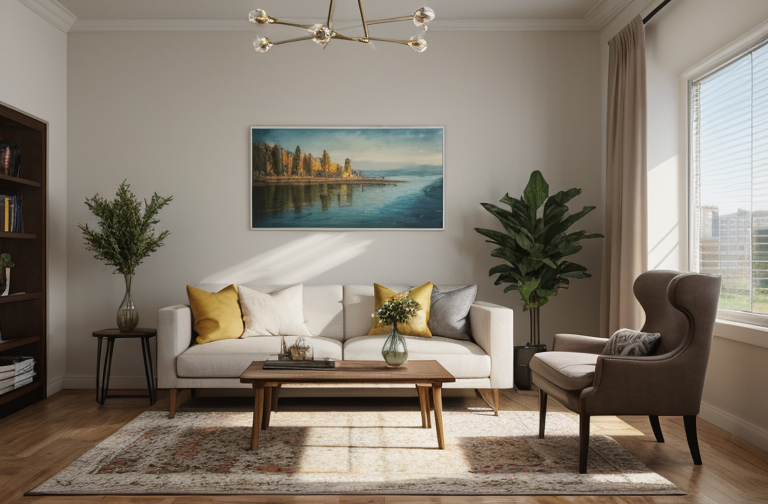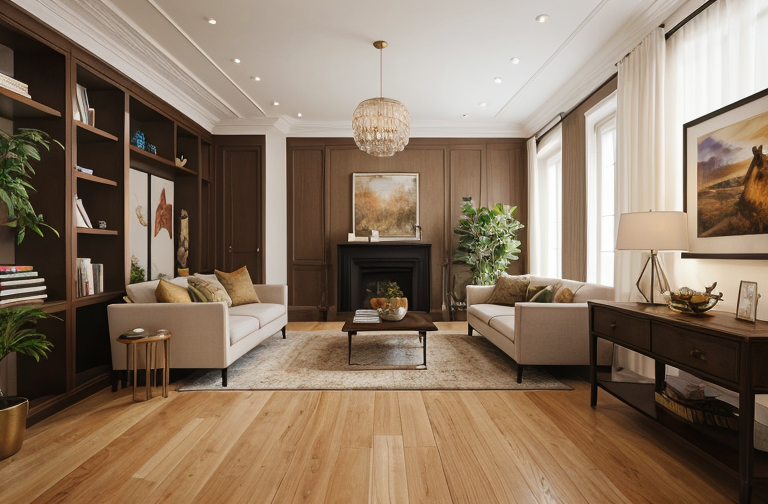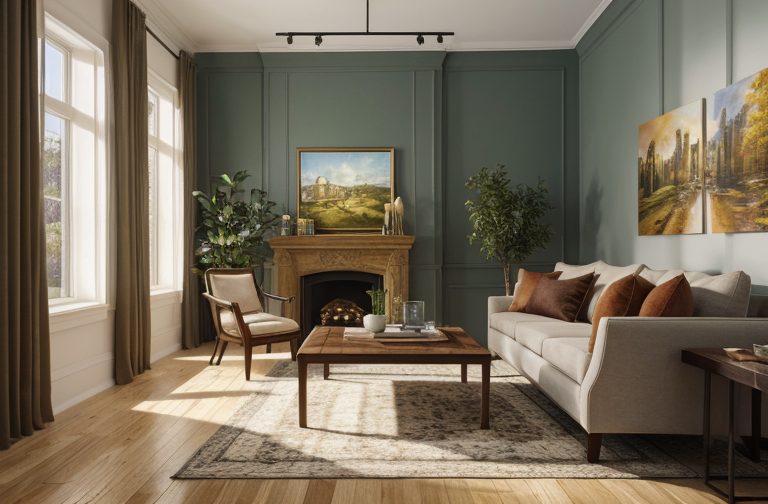Exploring the Harmony of Natural Materials and Diverse Styles in Modern Interior Design

The article discusses 2022 interior design trends such as the use of natural materials, blending design styles, color contrasts, creative use of space, cultural inspirations, and future predictions for 2024.
Exploring Natural Materials in Interior Design
The sphere of interior design often reflects the balance between form and functionality, and the use of natural materials such as wood, concrete, and rammed earth walls is a potent testament to this principle.
Use of materials like wood, rammed-earth walls, and concrete
Such materials add an organic, earthy appeal to any space, setting the stage for what I like to call ’aesthetic sustainability’. Whether it’s a cozy reading nook graced with a wooden bookshelf, a living room adorned with an exposed concrete wall, or a rammed earth partition adding warmth to a minimalistic space each element has its own story to tell.
Impacts on the interior ambiance
By opting for these materials, spaces can be transformed into tranquil sanctuaries that emanate an ambiance of tranquillity. The understated elegance of raw wood, the edgy charm of concrete, and the rugged warmth of rammed earth walls hold the power to invite harmony into our daily lives. Incorporating these materials into my designs is one of my favorite ways to curate serene spaces that flourish within the realm of top house interior design.
Energy-efficiency considerations
Beyond the aesthetic appeal, these materials pose a compelling advantage in regards to energy efficiency. By preventing excessive heat loss, they contribute to a home’s sustainability profile. These materials not only anchor us to nature but also encourage stewardship of our environment on an everyday basis.
From the petite DIY projects I constantly engage in, to orchestrating a complete home makeover, I delight in showcasing the possibilities that these materials offer. They are undeniably the cornerstones of my design philosophy that seamlessly blend beauty and practicality.

The Art of Mixing Various Design Styles
In my years of experience, one aspect that continually fascinates me is conceptualizing unique interiors that blend a variety of design styles. Personally, I find it invigorating to fuse elements of contemporary, eclectic, traditional, minimalist, and other styles. The challenge lies not just in combining these aesthetics, but in achieving a balance where they coexist harmoniously, each contributing to the overall allure of the space.
Blending Contemporary, Eclectic, Traditional, Minimalist and Other Style Elements
I frequently lean into this dynamic approach that veers away from standard rules and stereotypes. Drawing from hues of different eras and locales, I believe that the beauty of these seemingly contrasting styles is that they can merge seamlessly when curated mindfully. And honestly, joy lies in the details, from a Bohemian bobo chair in a minimalist lounge to a contemporary art piece in a mid century modern room.
Creating Personalized Space
At the heart of my design philosophy is personalization. I strive to create spaces that lean on authenticity, declaring boldly the individuality and personal style of its inhabitants. The freedom to explore different design styles allows for an influx of creativity. This alcove here, and that study nook there, they contribute to painting a personalized, intimate picture, including them in the top 10 house interior design challenge and debate.
Examples of Design Style Combinations
Examples abound when it comes to mixing different design styles. One might blend an architectural fault line into an eclectic gallery wall or perhaps configure a traditional space to accommodate a minimalist aesthetic. These are just some of the paths to conception. There are countless design style combinations, each with its unique narrative, waiting to be explored.
Interlacing design styles transcends conventions, rules, and worldviews and does more than enhance the visual allure of a space. It becomes a catalyst of conversations, a stimulator of ideas, exploring spatial dimensions beyond the realms of convention. And above all, it carries the impressive potential to revolutionize the realm of interior design.

The Aesthetics of Space Interpretation
As someone who’s spent countless hours studying and perfecting the art of space interpretation, I’m a firm believer in using space to its full potential in all settings be it apartments, houses or retreats. Each room should have a purpose, and the design elements within it should serve that purpose while also enhancing the overall aesthetic appeal. It’s a concept I often refer to as ”purposeful design.”
Use of space in apartments, houses, and retreats
In smaller spaces, like apartments, I’ve seen and worked with designs featuring built in concrete seating and intentionally unfinished designs. These choices are designed to make the most of limited space, creating unique, stylish house interior design environments that capture the eyes as well as the heart.
Incorporating purposeful features in space planning
In bigger spaces, like houses or retreats, there’s more room to incorporate purposeful features. In these cases, decor choices can be as much about practicality as they are about form and design, fusing to create spaces that are practical yet gorgeous.
Encouraging indoor-outdoor living
One design concept that’s gaining traction is the seamless transition from indoor to outdoor living. This was previously limited to vacation homes and retreats, but it’s now becoming a staple in domestic spaces too. Incorporating large sliding doors, verdant indoor plants, and outdoor seating right on the threshold are some ideas that come to mind when picturing this stunning aesthetic.
Space interpretation in interior design is a way to make our spaces work for us, to create our little pockets of peace and creativity, no matter where we are.

Cultural Influence and Global Variety in Interior Design
As an interior design enthusiast, I’m always fascinated by the rich global tapestry of design inspirations. The beauty of our role in the interior design house is that we get to blend different artistic expressions and cultural influences, resulting in eclectic, globally inspired designs.
Diverse Cultural and Artistic Impact on Design
No design is an island. Regardless of how novel or modern a style may seem, they invariably carry hints of diverse worldly influences. Just as Picasso was inspired by African tribal art, modern interiors often incorporate motifs, textures, and colors from across the globe.
Global Diversity in Design Styles
Look around, and you’ll find design elements and influences drawn from myriad cultures and countries. From the bold colors of Mexican folk art to the subtle elegance of French Provincial style, the world of design is a vast, multicultural panorama.
Specific Examples of Cultural Inspiration in Modern Designs
Take for instance the Moroccan zellige tiles, known for their colorful mosaics and intricate patterns. They can transform even the simplest bathroom into an exotic, spa like retreat. Or consider the minimalist beauty of Japanese design, characterized by cleanliness and simplicity. Combine it with the warm, earthy tones of Scandinavian style, and you get Japandi—a modern design trend that’s both serene and cozy.
To comprehend the language of design, it’s essential to understand its cultural inspirations. The ability to appreciate and incorporate these diverse influences is an integral part of my process and ethos as an interior designer. Let’s continue to celebrate global diversity in design together!
Future Predictions and Unfinished Elements in Interior Designs
If you ask me about the future of design, I will confidently tell you that stylish house interior design isn’t about perfection anymore; it’s about authenticity. Authenticity has stood at the heart of top house interior design, and I predict this isn’t about to change any time soon.
Popular Design Aesthetics Predicted to Continue to be Relevant
Among the aesthetics predicted to remain significant in the coming years, the appeal of unfinished and exposed elements has gained momentum. It’s something I’ve been touting as part of the top 10 house interior designs for quite some time. I see this trend only growing in influence, backed by observations from major design publications.
Use of Exposed and Unfinished Aspects in Design
It’s fascinating how exposure has evolved from a mere design faux pas to a value add in the interior design house. Today, an exposed brick wall or visible concrete floor isn’t seen as an incompleteness, but brings a raw, industrial aesthetic to spaces. These unfinished elements bring such character and visual texture to rooms, creating intriguing design narratives.
The Increasing Attractiveness of Exposed Elements
More aesthetes are appreciating the beauty of ’unfinished’ design because it’s not necessarily about the unfinished look—it’s the feeling of authenticity it provides. As we look towards 2024, I predict that the popularity of these exposed elements in design will continue to rise, reflecting our collective search for genuineness and character.
Interior design isn’t always about hiding the perceived ’faults.’ Instead, it’s about embracing the unexpected, celebrating the unique, and relishing the authentic beauty inherent in each design element. After all, isn’t that what top house interior design, indeed any form of design, is all about?
- Unlocking the Intricacies of Interior Design: Ranch-Style Homes and the Pursuit of Functionality
- Blending Tradition and Modernity: Exploring the Design of Nipa Hut and Trynagoal Tea House
- Enhancing Dining Experiences through Creative Interior Design and Rebranding in Burger Restaurants
- Mastering Home Renovation: The Crucial Roles of an Interior Designer and Effective Budget Management
- Understanding the Value of Interior Designers: Roles, Benefits, and Selection Process
- Exploring the Richness of Turkish Architecture and Interior Design through Adobe Stock and Pinterest
- Unveiling the Unique Characteristics and Design Elements of Ranch-Style Houses
- Embracing Openness and Personal Touch: The California Ranch House Interior Design Concept
- Embracing Warm Minimalism: The Rise of Brown Tones in Interior Design
- Enhancing Your New Home: Key Elements and Strategies in Interior Design
- Unveiling the Art of Luxury Interior Design: Exploration of Materials, Individual Style and Inspiration from Pinterest
- 13 Easy and Affordable Tips to Spruce Up Your Home Decor
- Exploring the Rich History and Distinctive Features of Tudor Architecture
- Exploring British Home Interiors: From Historical Evolution to Modern Adaptation
- Traversing the World of Interior Design: From Designer Profiles to DIY Ideas and Future-ready Furniture
- Contemporary Home Refinement: Leveraging Exposed Brick Design and Affordable, High-Quality Furnishings
- Exploring the Warmth and Charm of Modern Rustic Interior Design
- Enhancing Duplex and Triplex Interiors: An In-Depth Guide to Style, Lighting, and Effective Use of Space
- Creating Your Dream Bathroom: A Comprehensive Guide to Designs, Functionality, and Material Selection
- Creating Your Personal Spa: Insights into Modern Bathroom Design Trends



